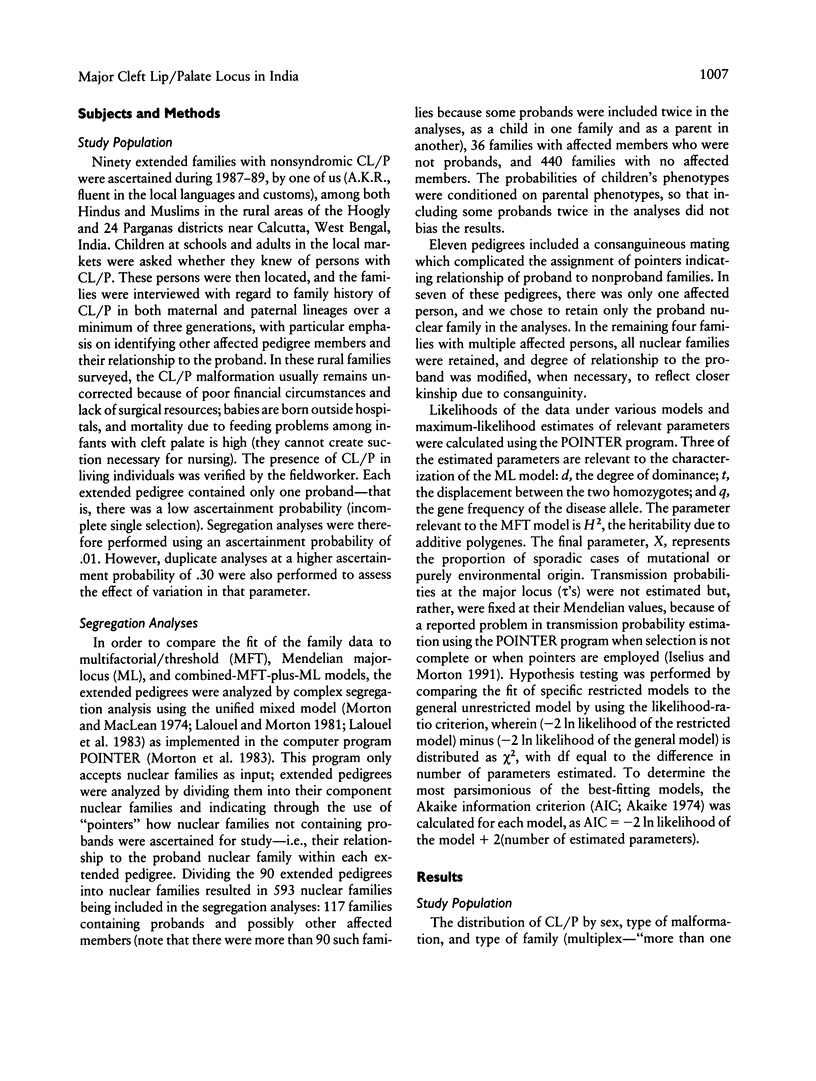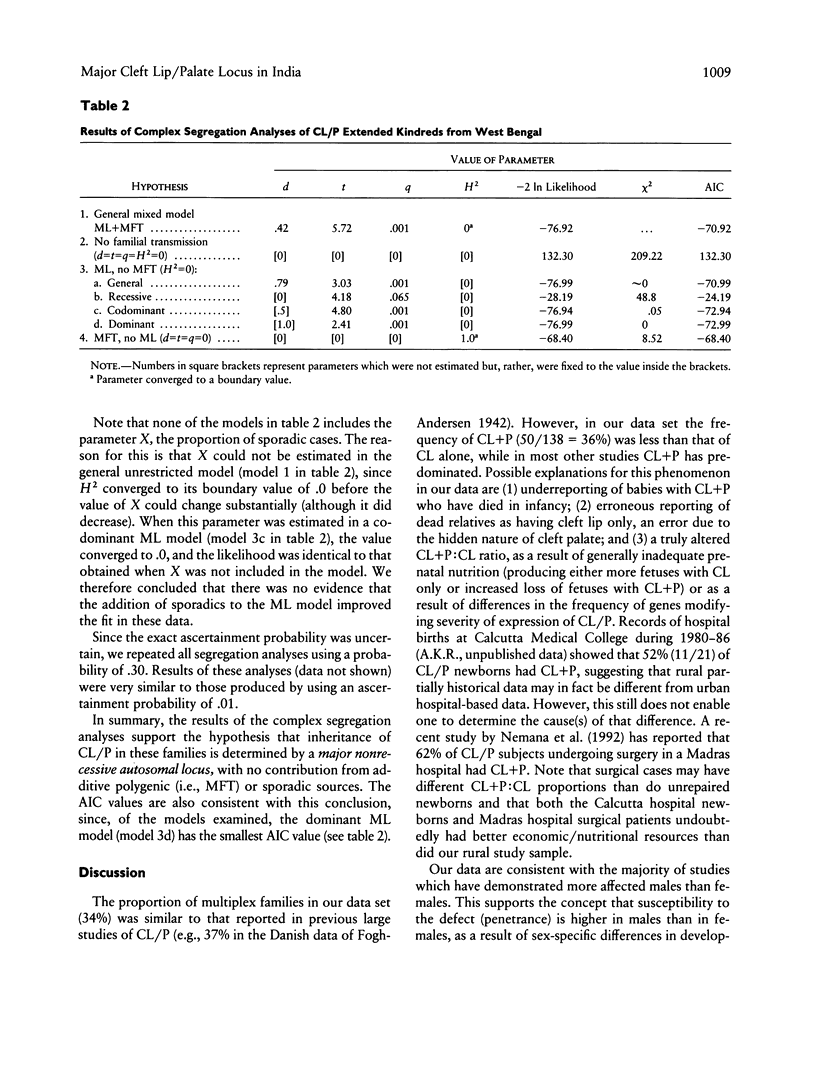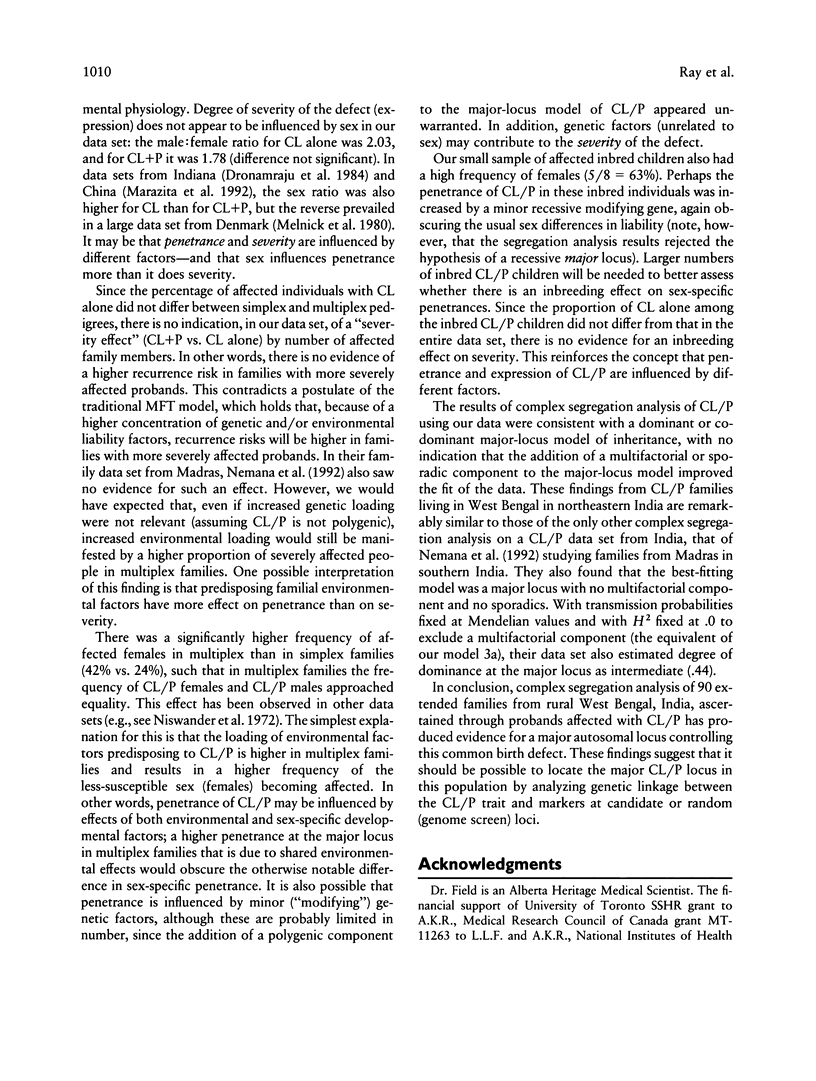Abstract
Ninety extended families having one or more individuals affected with nonsyndromic cleft lip (CL) with or without cleft palate (CL/P) were ascertained in rural West Bengal, India. These families included 138 affected people, 64% of whom had CL alone and 66% of whom were male. Multiple-affected-member ("multiplex") pedigrees were less common than single-affected-member ("simplex") pedigrees, composing 34% of all extended pedigrees. There was no difference between multiplex and simplex pedigrees in the frequency of affected persons with CL alone, but multiplex pedigrees had a lower frequency of affected males (58%) than did simplex pedigrees (76%; P = .02). Complex segregation analysis using the POINTER computer program rejected both the hypothesis of no familial transmission (P < .0001) and the hypothesis that familiarity could be explained solely by a multifactorial/threshold model (P < .05). The hypothesis of major-locus inheritance alone could not be rejected. Among major-locus models examined, strictly recessive inheritance was rejected (P < .0001), but codominant and dominant models were not. Neither the addition of a multifactorial component nor the addition of a proportion of sporadic cases to the major-locus model improved the fit of the data. In conclusion, the results of complex segregation analysis were consistent with a dominant or codominant major-locus mode of inheritance of CL/P in these families.
Full text
PDF





Selected References
These references are in PubMed. This may not be the complete list of references from this article.
- Dronamraju K. R., Wakim K. G., Smith D. J., Bixler D. Fetal mortality in oral cleft families (IX): factors relating to the occurrence of sporadic clefts. Clin Genet. 1984 Oct;26(4):322–330. doi: 10.1111/j.1399-0004.1984.tb01067.x. [DOI] [PubMed] [Google Scholar]
- Farrall M., Holder S. Familial recurrence-pattern analysis of cleft lip with or without cleft palate. Am J Hum Genet. 1992 Feb;50(2):270–277. [PMC free article] [PubMed] [Google Scholar]
- Lalouel J. M., Morton N. E. Complex segregation analysis with pointers. Hum Hered. 1981;31(5):312–321. doi: 10.1159/000153231. [DOI] [PubMed] [Google Scholar]
- Lalouel J. M., Rao D. C., Morton N. E., Elston R. C. A unified model for complex segregation analysis. Am J Hum Genet. 1983 Sep;35(5):816–826. [PMC free article] [PubMed] [Google Scholar]
- Marazita M. L., Hu D. N., Spence M. A., Liu Y. E., Melnick M. Cleft lip with or without cleft palate in Shanghai, China: evidence for an autosomal major locus. Am J Hum Genet. 1992 Sep;51(3):648–653. [PMC free article] [PubMed] [Google Scholar]
- Melnick M., Bixler D., Fogh-Andersen P., Conneally P. M. Cleft lip+/-cleft palate: an overview of the literature and an analysis of Danish cases born between 1941 and 1968. Am J Med Genet. 1980;6(1):83–97. doi: 10.1002/ajmg.1320060108. [DOI] [PubMed] [Google Scholar]
- Mitchell L. E., Risch N. Mode of inheritance of nonsyndromic cleft lip with or without cleft palate: a reanalysis. Am J Hum Genet. 1992 Aug;51(2):323–332. [PMC free article] [PubMed] [Google Scholar]
- Morton N. E., MacLean C. J. Analysis of family resemblance. 3. Complex segregation of quantitative traits. Am J Hum Genet. 1974 Jul;26(4):489–503. [PMC free article] [PubMed] [Google Scholar]
- Niswander J. D., MacLean C. J., Chung C. S., Dronamraju K. Sex ratio and cleft lip with or without cleft palate. Lancet. 1972 Oct 21;2(7782):858–860. doi: 10.1016/s0140-6736(72)92217-9. [DOI] [PubMed] [Google Scholar]


